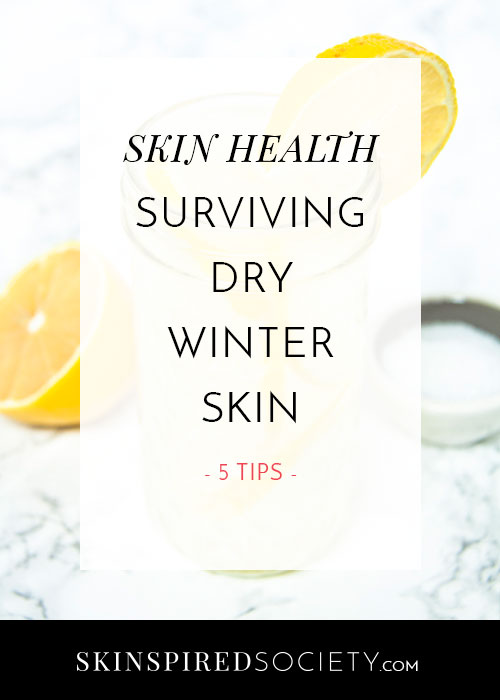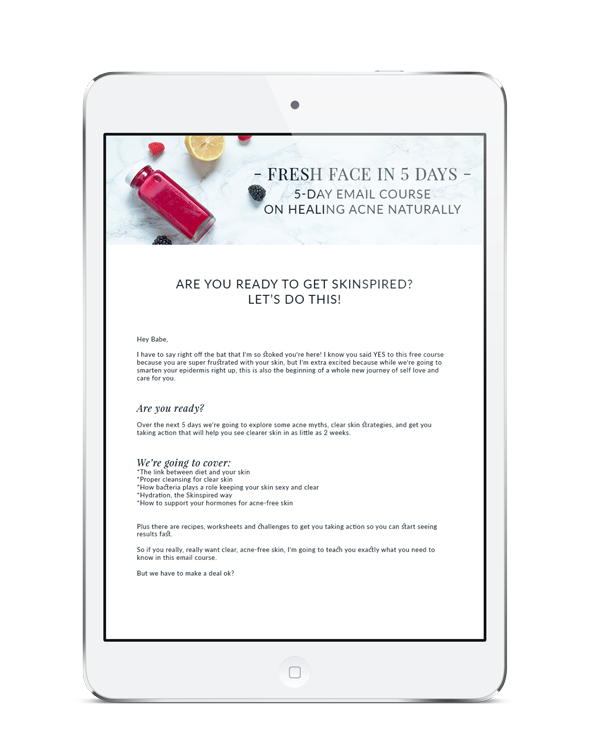We are a few days out from the official start of winter, but dry skin doesn’t always wait for the official winter solstice. The struggle of dry winter skin is real and can wreak havoc on our bodies. From embarrassing flakey skin on the face that makes it impossible to wear makeup to an increase of pimples and breakouts that make you feel like a teenager again, and even red, painful cracked lips that you swear everyone is staring at.
I am a full believer in promoting healthy skin the natural way, so I’m sharing 5 easy, safe and natural strategies to hydrate your skin this winter. Plus, if you want even more info, be sure to register for this totally free dry skin webinar:
SIGN-UP FOR OUR MAILING LIST & GET YOUR FREE WEBINAR:
Surviving Dry Winter Skin
LEARN SAFE & NATURAL STRATEGIES FOR BEAUTIFUL, GLOWING SKIN ALL WINTER LONG.
We may collect, use & process your data according to the terms of our privacy policy.
1. Wake up to Smarter Water
A really great way to start your day is with a glass of water. It can be challenging to get enough fluids into our bodies during the winter months. During this time of year, we tend to eat more concentrated, grounding foods, such as meats and root vegetables, and these foods require more fluids from the body to digest. Add to this that we generally aren’t as thirsty as compared to summer months when it’s more humid and we’re more active.
To help you hydrate smarter this winter, try this: Upon waking in the morning, pour yourself a nice glass of water. But instead of just regular old tap water, here are a few recommendations to make your water even more hydrating:
- Be sure that your water is room temperature or warmer, and not cold. Cold water can zap your digestive fire, making it harder for your body to do its job in breaking down foods and getting the hydrating nutrients it needs from your food.
- Up the electrolytes in your H20. Have you ever noticed that you can seem to drink glass after glass of water, but never feel hydrated? That’s likely because your electrolyte levels are low. Try adding some fresh lemon juice and a pinch of mineral-rich sea salt. When the salt is added to the water it dissolves into its ion component parts, which help facilitate cell hydration. The lemon contains calcium, potassium, and sugar, which, when combined with salt, provide a balance for pH and fluid levels in the body.
If water is not your thing, another great option is coconut water! It has a natural balance of sugar and electrolytes, making it super hydrating. Add it to smoothies, or drink it on its own.
2. Turn Down the Dial on Hot Showers
I know hot showers are LIFE in during the cold winter months, but they can significantly exacerbate dry skin. I used to make my showers as hot as I could bear them, but the heat actually strips away your skin’s natural oils, allowing for water to evaporate more quickly from your skin.
Instead, opt for warm showers over hot, and if you can keep them shorter (under 10 minutes), all the better! Are you more of a bath person? Unfortunately, baths can also dry your skin out just as easily as a shower – I know, the world’s a cruel place!
To help keep your skin hydrated during and after a shower I recommend avoiding over cleansing with a strong soap. Try washing only the places where you sweat, like your pits and your bits, and just rinse the rest of your body with water. After your shower, patting your skin dry with your towel, not rubbing, will also help protect your skin. And lastly, moisturize immediately after getting out of the shower, even while you’re still a little damp, to help seal in your skin’s moisture.
3. Make Fat Your Friend
Healthy skin needs healthy fats. Sebum is your body’s natural moisturizer. It’s produced in the skin in the sebaceous glands, using fatty acids. Some of the fats used to make sebum come from our available fat stores, but some also come from the diet.
If you’ve subscribed to a low-fat diet, there’s a chance you may not be getting the dietary fat required to maintain proper sebum levels for your skin to feel hydrated. Fat really is your friend, and ensuring you get plenty of healthy fats such as avocado, wild-cold water fish, coconut oil, and unheated olive oil, not only will help your waistline by improving your hormones & metabolism, but the fat will also help your skin’s moisture levels.
4. Ditch the Diuretics
With all the holiday parties and darker mornings, the winter months don’t exactly make it easy to avoid alcohol and coffee. However, both caffeine and alcohol have diuretic properties that stimulate your kidneys to produce more urine, extracting water from the blood and cells.
My recommendation is to try and not overdo it! Try and cut back on coffee, opting for herbal teas instead. Also, if you’re at a party, try having one glass of water for every alcoholic beverage you consume to keep your hydration up.
5. Supplement with EFAs
Cold water fish, like salmon or sardines, are high in Essential Fatty Acids (or EFAs) but aren’t typically a go-to protein in the wintertime. Personally, I tend to reach for more grounding proteins like red meat, that I can cook up in a hearty stew. Because of this, I find that my skin is happier when I give it a little extra help with a good quality fish oil or krill oil supplement.
Fish oils help your cells maintain their health by improving circulation in the body and sending hydration and nutrients to the skin cell. Hello, plump and hydrated skin!
EFAs maintain healthy blood circulation in the body, supports adrenal function, transports fat-soluble vitamins to the cells, and promotes healthy skin. I find that it helps with everything from lightening dark circles to dry skin to acne.
This is just scratching the surface in possible ways that you can help your skin maintain its hydration during the winter months. Don’t miss this totally free webinar on Surviving Winter Dry Skin. Click the button below to get free instant access!




You have written an excellent article! Thank you for these amazing tips! I highly agree with taking a fish oil or a krill oil supplement, they are amazing for the skin AND for the brain, too. 🙂 I also agree about consuming avocados and olive oil! I would also add olives, they are healthy and delicious.
I had no idea about adding sea salt in a glass of water, that’s brilliant!
Love your Pinterest image! 🙂
Olives! Yes! Such a good addition of a healthy fat!